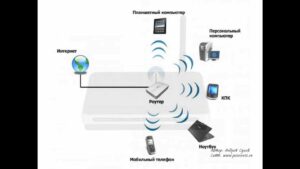- Methods for determining a computer's IP address
- Using the Command Line on Windows
- Finding an IP address in the network connection settings
- Determining the IP address through a browser
- How to use your computer's IP address
- Remote computer access
- Setting up network applications
- How to hide your IP address
- Using VPN services
- Proxy servers and their features
Methods for determining a computer's IP address
There are several ways to determine the IP address of a computer. One of the easiest is to go to iplogger.com and get your IP address. Just copy it and use it as you wish. If you want to get the IP address in the Windows operating system, you can use the ipconfig command. To do this, press Win + R, type cmd and press Enter. In the command line window that opens, type ipconfig and press Enter. You will see information about your network, including the IP address. You can also use online services to determine the IP address, for example, whatismyip.com or myip.com. If you want to get the IP address of another computer on the local network, you can use the ping command. In the command line, type ping and the IP address of the computer you want to check. You will see a response with the IP address of this computer. As you can see, determining the IP address of a computer is not difficult. With the help of simple tools, you can find out your IP address or the address of another computer on the network.
Using the Command Line on Windows
The Command Prompt in Windows is one of the most powerful tools that can be used to find the IP address of a computer. To get started, open the command line by clicking on the “Start” button and entering “cmd” in the search bar. Launch the program by selecting “cmd.
exe".
To find out the IP address of your computer, enter the command “ipconfig” and press the “Enter” key. In response to this command, the computer will display a list of network adapters and their configuration. Find the adapter you use to connect to the Internet in the list and look for the "IPv4 Address" line. This line contains your computer's IP address.
You can also find out the IP address of another computer on your network using the “ping” command. To do this, type “ping [computer address]” into the command line and press “Enter.” The computer will send a ping signal to the specified address and return information about the response time and IP address.
Using the Command Prompt in Windows can be very useful, especially when working on the network. This is a tool that should be in every Windows user's arsenal.
Finding an IP address in the network connection settings
If you are looking for the IP address of your computer, then one of the easiest ways is to look for it in the network connection settings.
To do this you need to follow these steps:
1. Click on the "Start" button in the lower left corner of the screen.
2. In the search bar, enter “Control Panel” and select it from the list of search results.
3. In Control Panel, select Network and Internet.
4. Next, select “Network Connections”.
5. Find the active connection and right-click on its icon.
6. Select Properties.
7. In the window that opens, select “Internet Protocol version 4 (TCP/IPv4)”.
8. At the bottom of the window you will see the IP address of your computer.
Now you know how to find the IP address of your computer using the network connection settings. This can be useful, for example, for setting up network connections or when testing network equipment.
Determining the IP address through a browser
If you want to find out the IP address of your computer, but don’t want to bother with the command line, you can use a browser. There are several ways to determine an IP address through a browser.
The first way is to use a website that displays your IP address. For example, you can go to https://www.
whatismyip.
com/ru/ and see your IP address immediately on the main page.
The second way is to use the browser's built-in function. For example, in Google Chrome, you can type “chrome://settings” in the address bar, then go to the “Advanced” section, then “Network” and click on the “Change proxy settings” button. In the window that opens, you need to select the “Details” tab and your IP address will be indicated there.
The third way is to use online tools that allow you to find out the IP address. For example, you can use the site https://www.
iplocation.
net/ip-lookup or https://www.
whatismyip.
com/ru/ip-whois-lookup/.
Regardless of the chosen method, finding out the IP address of your computer through a browser is very simple and fast.
How to use your computer's IP address
The IP address of a computer plays an important role in network communication. It allows you to establish communication between devices and transfer data. But how to use your computer's IP address in everyday life? Below we will look at several methods.
1. Remote access. If you want to access your computer remotely, you need to know its IP address. There are many programs for remote access, such as TeamViewer or AnyDesk. You just need to enter the IP address of the computer you want to connect to and enter the password.
2. Hosting. If you want to create your own website, you need to register a domain name and specify the IP address of the hosting server. This will allow users to access your site through a browser.
3. Security. An IP address can be used to protect your computer. For example, you can set up a firewall to block access to certain IP addresses or set up a VPN to connect to the network securely.
In conclusion, a computer's IP address is an important element of network infrastructure. It can be used for remote access, website hosting or security. Therefore, it is always worth knowing your IP address and being able to use it in the right situations.
Remote computer access
Remote computer access can be very useful if you need to work on your computer from anywhere there is an Internet connection. There are many ways to access a computer remotely, but one of the most popular is to use an IP address.
In order to remotely access a computer using an IP address, you need to know the IP address of your computer. To find your computer's IP address, you can use the command line or network connection properties.
If you are using Windows, you can open a command prompt and enter the 'ipconfig' command to find out your computer's IP address. If you're using a Mac, you can open System Preferences, select Network, and find your computer's IP address under Connection.
Once you find your computer's IP address, you can use remote access software such as TeamViewer or Remote Desktop to access your computer remotely.
However, do not forget about security when using remote access to your computer. Make sure your password is secure and do not use open Wi-Fi networks to access your computer.
Overall, remote computer access using an IP address can be a very useful tool for working from anywhere. But don't forget about the safety and protection of your data.
Setting up network applications
To use network applications, you must have a properly configured Internet connection. To do this, you need to know the IP address of your computer.
If you are using a Windows operating system, you can find your computer's IP address as follows:
1. Click on the 'Start' button and select 'Run'.
2. Enter the 'cmd' command and click 'OK'.
3. In the window that opens, enter the command 'ipconfig' and press 'Enter'.
4. As a result, a list of network adapters, their IP addresses and other information will appear.
You can also find out the IP address of your computer by going to a special website, for example, myip.
com or 2ip.
ru.
Once you know your computer's IP address, you can configure network applications, such as a browser or email client. To do this, you need to specify in the settings the IP address of the computer and the port through which the connection will be made.
Setting up network applications can be challenging for first-time users, so don't hesitate to seek professional help or search the web for information.
How to hide your IP address
Hide your IP address - this is important for those who protect their privacy on the Internet. There are several ways to hide your IP address, we will look at the most popular ones.
1. Using VPN services. VPN (Virtual Private Network) is a technology that allows you to establish a secure connection between a computer and a server. VPN services mask your IP address, replacing it with the IP address of the server you are connected to.
2. Using proxy servers. A proxy server is an intermediary between your computer and the Internet. It hides your IP address, replacing it with its own.
3. Using the Tor browser. Tor browser is a browser that uses Onion Routing technology to hide your IP address. All requests through the Tor browser go through multiple nodes, making them impossible to track.
Choose one of the above methods and hide your IP address to protect your online privacy.
Using VPN services
VPN (Virtual Private Network) is a technology that allows you to provide a secure and confidential connection between computers on the Internet. It creates a secure tunnel between your device and the internet that hides your IP address and encrypts data sent over the network.
The use of VPN services is especially relevant in our era, when more and more people work from home and use the Internet to transmit confidential information. VPN protects data from hacking and theft, and also allows you to bypass geo-restrictions to access blocked sites.
There are many VPN services that offer different features and functionality. Some of them are free, but they usually have limitations on speed and number of available servers. Paid VPN services offer better speeds and more servers, as well as more reliable data protection.
When choosing a VPN service, you need to consider factors such as speed, number of available servers, encryption protocols, data logging and price. Some of the most popular VPN services include NordVPN, ExpressVPN, CyberGhost and Private Internet Access.
Using a VPN service is a simple and effective way to ensure the security and privacy of your Internet connection. All you need is to choose a suitable VPN service and connect to it.
Proxy servers and their features
Proxy servers are programs that allow you to hide the real IP address of the user’s computer and replace it with another one. This can be useful in cases where you need to ensure anonymity on the Internet or bypass blocking access to certain sites.
However, not all proxy servers are equal. There are free and paid, as well as proxy servers with varying degrees of protection and speed. When choosing a proxy server, you must take into account its features and use only reliable and verified sources.
Free proxy servers may not be entirely secure, as they can be used by attackers to steal personal data or distribute malware. They may also have slow speeds and limited bandwidth.
Paid proxy servers, as a rule, provide a higher degree of protection and speed, as well as a wider volume of available traffic. However, they may be more expensive than their free counterparts.
When choosing a proxy server, you must take into account its features and use only proven and reliable sources. It is also necessary to remember that using a proxy server does not guarantee complete anonymity on the Internet and does not protect against all types of threats.
Read further:






